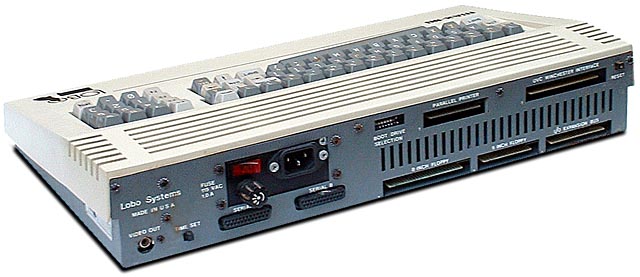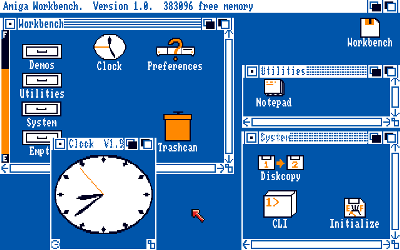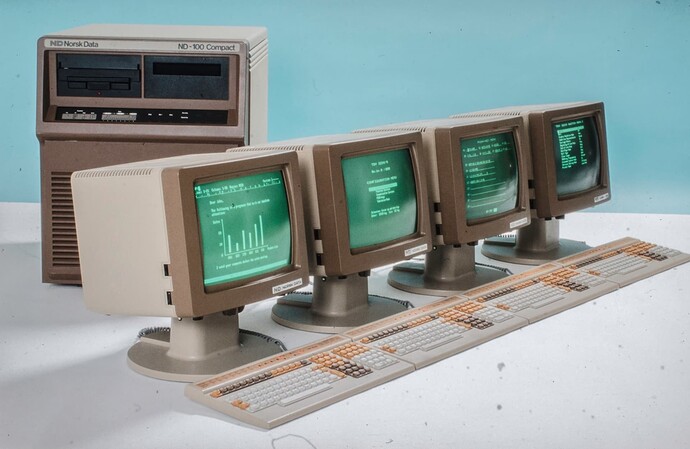It was ALL command line and I didn’t have a Unix background, so I was turned off until I found out there were GUIs available in the 2000’s. I started with KDE and stuck with it all these years. Always had a workhorse of a computer, so the resource hog of KDE was never a problem. I tried Red Hat first, but soon found OpenSuSE. I fell in love with OpenSuSE and it is my favorite as it supports the newbie, amateur, advanced, expert, and sysadmin. You can do almost everything with the GUI, or use the command line for nearly everything for granular control.
Thanks for sharing that. I am lucky (perhaps) because I started using Linux when it was no longer a geek-only operating system.
Having started personal computing in the 1970’s, I accepted the command line as the marvelous interface it was. My radio shack TRS-80 had a great command line interface and eventually had tricks like virtual terminals so you could switch among them. It was switching, not multi-tasking. It was great!
The ultimate TRS-80 compatible computer in 1982 was my Lobo Max-80, which could run LDOS (TRS compatible) and CPM. It was still character-based but had double the memory of the radio shack.
I started using Andrew Tanenbaum’s Minux about the same time in my graduate OS class although it didn’t get the X GUI until much later. Minux was unreliable but great for understanding OS. It used to take me days to make a simple modification to Minux and get it to boot. LOL!
My first GUI-based computer was the Amiga Model I, introduced in 1985. It was amazing for its time. Great GUI. I also used IBM OS/2, which introduced its GUI 1988.
I think my first Linux came on a floppy in 1992-3. No GUI, but GNU utilities including BASH and GCC. Living high there. I didn’t use X11 on Linux until 2004. It was a resource hog and I didn’t want it using up all my CPU. Linux was wonderful! It offered both command line and GUI. A perfect OS for me!
First time I “used” Unix was on a Data General AViiON system (dual Motorola 88010 RISC CPUs + 128 MB RAM!) running DG-UX in 1992/1993 at my work (a medium sized “teaching” hospital)… The machine wasn’t actually “in production” - and I’d just gotten into POVray on MS-DOS, so “we” got a copy of POVray “C” source off Compuserve and compiled it to run on the AViiON - man that thing was FAST compared to rendering in DOS on a 386…
Next time I used Unix was at Uni (circa 1993/4) using Pine and Usenet through a terminal (I think it was AIX?)… Then at another hospital used SunOS (i.e. BSD like UNIX from Sun Microsystems) and DG-UX…
Towards the end of 1995 - I read about Linux in Byte magazine - and the hospital I was working at had a link via a University (school of medicine) ISDN line to the internet - and found a mirror (mirror.aarnet.net.au - still around) hosting Slackware 3.0 - grabbed it floppy image by floppy image (20+) then got it to run on a spare 386 (barebone chassis with motherboard and massive ESDI hard disk and 8 MB RAM) I had at home… if I wanted ethernet support (was using COAX) I had to compile in the NIC driver, interrupt and DMA address into my kernel then boot! If I wanted sound support (soundblaster) had to compile that into the kernel… it was all CLI back then, tried “X” a few times - it was okay - but I was mostly intrigued by the power of the shell… got it to run ipchains (predecessor of iptables) and act as a gateway to PPP via my University dial up account - and shared with my other computer and my wife’s computer…
Anyway - I used Linux on and off for the next 20 or so years… UNIX (mostly Solaris) was my job, but also did Linux support (and some FreeBSD and NetBSD support, and ugly ugly SCO OpenServer)… Always thought of it more as core server O/S rather than a desktop… Occasionally ran a Linux desktop on spare hardware, occasionally dual booted…
But in 2012 Valve released two games on the Steam platform for Linux : Left 4 Dead 2 and Serious Sam III - and since then I’ve been 100% Linux on the desktop! I mostly use Ubuntu (usually the latest LTS) just 'cause I remember what a PITA it was spending hours building a kernel (only to have it not boot!) - and Ubuntu is pretty much more plug and play than anything from Redmond!
Attached - keeping in the Holiday spirit : POVray output of Santa I rendered on that DG-AViiON back in '93.
Back then - it was all “hand coded” using a text editor using geometry primitives and CSG (boolean)… I did much better stuff than this - but no longer have it on disk… e.g. used it to render an animation of a rotating vase with Bart Simpson animated as a projected bitmap on each frame which was part of an assignment in Computer Graphics for my uni course.
I’m not sure I’d agree with the assertion that Linux is no longer a geek only OS even today.
I know that I’m probably taking an upopoular position with that, but to this day, even a minor issue seems to elicit the response, “just open a terminal and…”.
I really think that should not be the go-to action for non-power-users in this day and age.
I started using Linux with SuSe around version 9.0/9.1 (I got a boxed version). I remember even then getting frustrated with trying to follow instructions on building from source files not seeing where I had gone wrong when things failed. I remember thinking that I just wanted to use my computer, not get stuck in a mire of terminal commands.
I still return to Linux, because I appreciate its philosophy, but I’m reluctant to use it full time or recommend it any more, because it still feels unready for anyone that falls between basic user (email and web browsing) and power user.
I tried Ubuntu when it first came out and couldn’t get along with it back then. I have returned to Linux in the last two years and am amazed at how easy it is to use, as easy as Windows XP or 7 but better than both. I completely, disagree with your comments about not recommending it to others, I use Mint and recommend it to all. We are in our 60s and have not problems at all with and when we do there is help available far more than in my experience for Windows. I am one who falls between basic and power users, so I have to disagree with you on that. As for using the terminal I have only ever used it to do an auto clean, because I have found that best. I know from talking to others that once they see how great Linux Distros they switch over to them and only use windows if they really have to
Wow! that’s some history lessons for me. Thanks for sharing.
Hmm… you do have a point but comparing to what Linux was 10-12 years ago, it’s a lot easier to use these days.
I am 60. I started with Linux mint in 2006. I tried many distros and stayed mostly with Mint. I use Windows only for AutoCAD and that will be soon gone as I have Bricscad that works even better than AutoCAD and it works on Linux. In any case, I totally agree with ElectricDandySlider. I am ot sure what you are referring to that is so complicated in the Terminal. Even if you don’t know what you are doing it is the easiest way to just copy and paste commands that can be found almost anywhere. It is way better than Windows and it is beyond ready - it is excellent to use. I have friends who never had a computer before, in their 70’s and they use it with pleasure. Sorry johnmccormack.ie, but you don’t make much sense.
When I first started dabbling with Red Hat and Debian in 2002, I joked around:
If your idea of enjoying a piece of toast is to start out by grinding wheat, you’ll love Linux.
Even on many of the help forums (AskUbuntu, etc) the answers can be mightily opaque.
But I wouldn’t be here if I didn’t see the immense value of Linux.
I started using Linux Knoppix back in 1998. Played some with it, and other distros over the years, but have settled down with Mint-MATE for about 10 years now. Also, played a lot this past year with many different versions of Puppy, and for some really old equipment, I install uPupBB18.04. I still distro hop, trying out new, and different Linux OS’s, placing the iso’s on an SD card, with the program MultiBoot.(Kind of fun for me.)
BTW-I’m 84 years young.
John, Linux is so easy my grandkids can use it. They hum through their Chromebooks at school. Windows is the big disappointment.
Welcome @rishab ,
Here is my path. Slightly different background because I have been in scientific computing.
I learnt to program on an IBM1620 in the 1960’s.
I worked for years on mainframes programming in Fortran.
I moved in the 1970’s to BSD Unix on a DEC minicomputer with a Motorola6800 motherboard. Ran at 4MHz.
Moved in about 1990 to SunOS on Sun workstations, then Solaris on workstations, where I first encountered X11 windows and graphics terminals, instead of just the command line on a character terminal.
Then in about 1993 I set up FreeBSD on 486 PC.
When I retired I kept on with FreeBSD on the old 486 for about 10 years, then got a laptop with WinXP, which I quickly junked and replaced with Debian Linux. I still have the laptop, it is now Void Linux - is a 686 at 3.3Ghz so it will support a small DTE like Xfce.
I eventually got a large corei7 desktop with Debian. It is now a multiboot with Debian, Void, Solus, Devuan and, just yesterday MX.
I originally made the move from FreeBSD to Linux , because Linux had better drivers. I dont know if that is still the case today.
The free software movement has contributed a lot to my ability to do things with computers. I have tried to put something back. I put R software in the public domain. itsFOSS is part of putting back too.
Regards
Neville
I started with serious computing in the 90s in uni. At this time, it were all UNIX workstations, mostly from SUN. So, when I decided to start with Linux, I had a rather smooth start.
At this time, there were only three major distributions: Slackware, RedHat and SuSE. SuSE had the fame of being the one with the best documentation and the biggest amount of software (6 CDs), so it was the natural choice. The standard desktop was fvwm2, but I switched to KDE when its version 1.0 appeared.
I used Windows and Linux in parallel, but I always felt more “at home” in the Linux world.
Over the years, I’ve been using Windows less and less, so about a year ago, I ditched Windows entirely. I still have a Windows 10 license, just in case I might need it, but it never happened (yet).
I started with mainly Slackware back in 2000 then Mandrake, it had a GUI that made things a little easier, then back in 2010 I tried Ubuntu stayed with that for a few years, moved to Linux-Mint afterwards but it felt to much like Windows. So I then tried Manjaro (Arch based). I found Garuda Linux (also Arch based) last year (2021) but I love that it’s very pretty and has many tweaks added to it. Think this maybe the one I will stay with for years to come. Mainly I use Linux as my every day driver but I still use windows as I’m a gamer, and many of the games I use are epic anti-Linux (cheat) protected games.
@Ltpessimist ’
Hi Jay . Your post is interesting because you have looked around at different distros searching for the most suited one for you. What desktop environment did you settle on?
And a point for all Linux fans. Do not forget that BSD is also FOSS and that BSD was actually available for PC’s before Linux in the early 1990’s
Regards
Neville
Hi @Mina ,
So you dont remember mainframes?
Just imagine this. SCOPE and NOS on Control Data mainframes - 6 character filenames, no extensions, no directory structure… just home space, no utilities or shellscripts , no package system, about 20 different file types, fortran compiler, and a thing called update for packing stuff onto tapes. Not open source. Access originally punch cards, then ASCII terminals over a 1200 baud network. . I was lucky… I had a fancy terminal with a scrollback button.
There is worse, try an IBM mainframe with JCL. Here you had to tell the OS how much disk space a file was going to take, in tracks and cylinders, in advance, before writing the file.
Makes you realize what an advance Unix was, especially with GNU added. To have an operating system which provided tools for doing things, as against having to write your own with a compiler, was of great benefit.
Cheers
Neville
I missed the punch card area. The oldest machine, I ever used, was a Norsk Data mini computer with ASCII terminals, where we did the assignments for our “introduction to computer based maths” course. Norsk had a proprietary OS (I think).
A year or two later, they were decommissioned and replaced by UNIX workstations with X11.
@Mina
It is interesting to note that most of the important algorithms for numerical analysis were developed in the pre-Unix era. ie with very primitive computing facilities.
Neville
This is actually no surprise. Algorithms had to be fucking efficient when computing power was expensive.
The basic methods for the numeric solution of differential equations (That’s what most big computers actually do) predate all electronic computers.
However, the algorithms used for modern combinatoric problems are (besides the classics) rather new.



